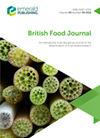Bee pollen usage as carrier material in the drying of honey and some properties of honey-bee pollen powders
IF 3.4
3区 经济学
Q1 AGRICULTURAL ECONOMICS & POLICY
引用次数: 1
Abstract
PurposeThe aim of this study was to produce an enriched honey powder with active compounds coming from bee pollen and investigate the effects of bee pollen addition as a carrier material on honey powder.Design/methodology/approachThe effects of bee pollen addition as carrier material in corporation with gum arabic at different ratios (25, 50 and 75% of total carrier material amount) on vacuum-dried honey-bee pollen powder were investigated.FindingsThe bee pollen concentration raise in the mixture increased the particle size, total phenolic, flavonoid and sugar contents and antioxidant activity, whereas decreased the Hauser ratio and Carr index values, hygroscopicity and solubility of enriched honey powder samples. The honey powder samples had passable and poor flow properties and very hygroscopic (>20%) structure because of the high sugar content. The phenolic and flavonoid contents of honey powder samples with bee pollen changed between 1531.59 and 3796.00 mg GAE/kg and 424.05–1203.10 mg QE/kg, respectively, and these values were much higher than the control sample. On the basis of linear correlation analysis, there was a very high positive correlation between total phenolic, flavonoid and antioxidant activity, while there was a very high negative correlation between these parameters and solubility.Originality/valueThe study evaluated that enriching of honey powders with pollen, which is a product of both plant and bee origin, rather than enriching with different plant and animal sources has an innovative approach. Additionally, the usage of bee pollen as a carrier agent in food drying has not been previously reported in any study.蜂花粉在蜂蜜干燥中的载体作用及蜂花粉粉的一些特性
目的以蜂花粉为原料,制备富含活性成分的蜂蜜粉,并研究添加蜂花粉作为载体材料对蜂蜜粉的影响。设计/方法/方法研究了不同比例(载体总用量的25%、50%和75%)添加蜂花粉作为载体材料与阿拉伯树胶配合使用对真空干燥蜂花粉粉的影响。结果:混合物中蜂花粉浓度的增加增加了浓缩蜜粉样品的粒径、总酚、黄酮和糖含量以及抗氧化活性,而降低了豪瑟比和卡尔指数值、吸湿性和溶解度。由于含糖量高,蜂蜜粉末样品具有可通过和较差的流动性能以及非常吸湿(>20%)的结构。蜂花粉蜂蜜粉样品的酚类和类黄酮含量分别在1531.59至3796.00 mg GAE/kg和424.05至1203.10 mg QE/kg之间变化,这些值远高于对照样品。在线性相关分析的基础上,总酚类、黄酮类与抗氧化活性之间存在非常高的正相关,而这些参数与溶解度之间存在非常低的负相关。独创性/价值该研究评估了用花粉富集蜂蜜粉的创新方法,花粉是植物和蜜蜂来源的产物,而不是用不同的植物和动物来源富集。此外,蜂花粉作为载体剂在食品干燥中的应用以前没有任何研究报告。
本文章由计算机程序翻译,如有差异,请以英文原文为准。
求助全文
约1分钟内获得全文
求助全文
来源期刊

British Food Journal
工程技术-食品科技
CiteScore
6.90
自引率
15.20%
发文量
219
审稿时长
18-36 weeks
期刊介绍:
After 115 years, the British Food Journal (BFJ) continues to be highly respected worldwide for its broad and unique interdisciplinary coverage of the latest food-related double blind peer-reviewed research. It links all sectors of this dynamic industry, keeping abreast of emerging trends, topical and controversial issues and informing and stimulating debate. - See more at: http://emeraldgrouppublishing.com/products/journals/journals.htm?id=bfj#sthash.O3wH4pEh.dpuf
 求助内容:
求助内容: 应助结果提醒方式:
应助结果提醒方式:


